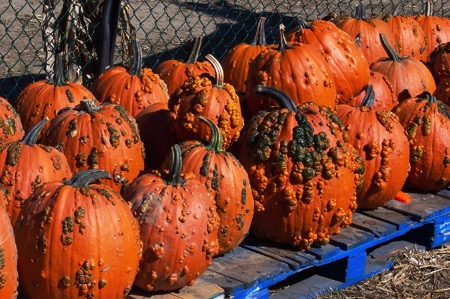By now, of course, you know the difference between a true zucchini and a cocozelle. In the course of researching that little gem, I came across one of the stranger byways in the annals of pumpkin science.

In December 2007, Siegers Seed Co., of Holland Michigan, applied for a US patent for “warted pumpkin”. The patent helpfully tells us that such a pumpkin has an “at least one wart associated with the outer shell of the body”. And, while IANAPL, it seem to me that the patent attempts to cover any warted pumpkin whatsoever, no matter how large, prominent or numerous said warts may be.
Which is very odd because warted pumpkins are nothing new. And again, IANAPL, but I thought that a patent had to include some sort of novelty.
As Hank Will, then as now Editor in Chief at Grit magazine wrote:
My ancestors grew warted gourds, pumpkins and squashes long before Siegers was even in business, and they received the seed from Native American gardeners who had warted cucurbits in their patches for who knows how long.
Will listed five examples of “prior art,” including a description from the granddaddy of cucurbit taxonomy, Antoine Nicholas Duchesne. The lack of novelty was one of the factors that led the US Patent & Trademark Office to reject the application in quick time. The rejection even cited images from our friends at Seed Savers Exchange to show that warty pumpkins had long been in existence. The patent rejection, however, was “non-final” and I have not been able to find out what happened after that. 1
How did Siegers come to invent the warty pumpkin that everyone else seems to have known about forever? The “inventor” (who was a director of marketing at Siegers) was both very observant and very inexperienced.
In a large commercial field of multiple unknown pumpkin varieties, a single fruit was discovered displaying a greater degree of warting than has ever been observed in prior experience by the inventor.
The brilliant marketing idea was that these warty pumpkins would make extra ghoulish Jack-o-lanterns, and Siegers even went so far as to register the trade name Super Freak, with varieties called Knucklehead and Goose Bumps, and one called Gremlins that I swear is a repackaged version of the “ornamental gourds” that were all the rage dried, varnished and gathering dust a while back.
One independent trial concluded:
We had both of these in our trials and thought they were sort of ugly, but nonetheless, they appeared to be a hot item at a garden center where we test-marketed them. These varieties will not be easy to use as carving pumpkins because of the hard shell associated with the warty character.
So maybe it was a good marketing idea, even if it was a terrible idea to claim novelty and a patent.
Thanks Lori Holder-Webb for making your picture of warty pumpkins available.
P.S. A website the company apparently created, “dedicated to the Superfreak™ Series,” and designed to give “growers and consumers alike … valuable information about all of Siegers Seed Company’s unique pumpkins, gourds and fall specialty items” 2 has been overrun by spam. That seems kinda fitting.
- If you know, let me know.
- From here.
On this subject, here is a photo I took of some knobbly squashes in a market in Provence a couple of weeks ago:
https://goo.gl/photos/FbguqE91z44jnujh6